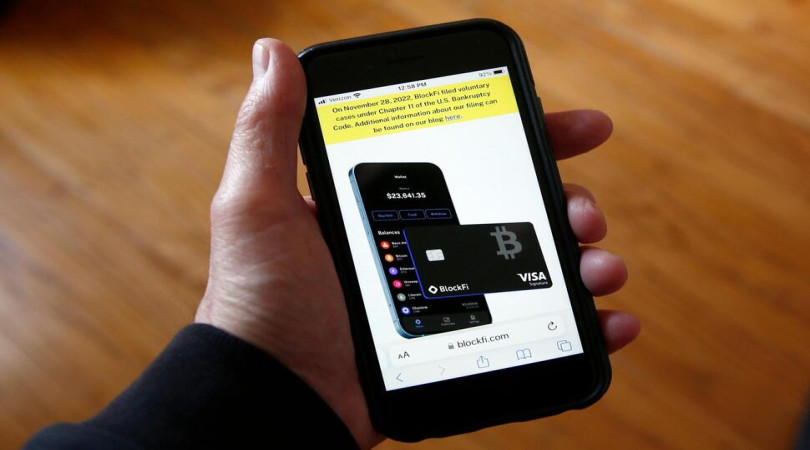Cryptocurrency enthusiasts are often encouraged to hold on to their crypto holdings for the long haul. But if you need money, you might consider cashing in some of your cryptocurrency to cover a major or unexpected expense.
Depending on how much you need, you may be able to use your cryptocurrency as collateral for a loan. Some crypto platforms also allow consumers to lend their digital assets, offering interest in exchange, similar to a high-yield savings account. Find out the different ways your crypto assets can work for you.
What Is Crypto Lending?
Cryptocurrency has experienced wild swings in both value and consumer interest as a speculative investment opportunity. But for enthusiasts who plan to HODL – an industry acronym for "hold on for dear life," meaning they won't sell their assets – there may be opportunities to get more value out of their digital currencies.
One way is to use your digital assets to borrow money when you need it. Another is to lend your cryptocurrency and earn interest instead of paying it.
Borrow Using Cryptocurrency
A crypto-backed loan is a collateralized loan that you can get through a crypto exchange or some other crypto lending platform. The loan functions similarly to a mortgage or car loan in that you're using an asset – in this case, your cryptocurrency – to secure your loan funds.
There are two types of crypto loans you can get using your digital assets as collateral:
Centralized finance: Also called CeFi, this involves borrowing money from a crypto or blockchain company that operates like a traditional financing system and controls your collateral while you pay off your loan. CeFi loans are more common and less expensive than decentralized finance loans.
Decentralized finance: Also called DeFi, this involves borrowing money through a decentralized blockchain. There's no central company or authority managing the process, and you retain control of your holdings – though the lender can still repossess your assets if you fail to pay your loan.
Read:
Best Mortgage LendersPros and Cons of Borrowing Using Your Cryptocurrency
Before you apply for a crypto-backed loan, it's important to consider both the advantages and disadvantages:
Pros
- Interest rates are relatively low. Cryptocurrency lending platforms generally offer crypto-backed loans with annual percentage rates in the single digits, which is less than the rates for many credit cards and unsecured personal loans.
- There's no credit check. There's typically no credit check involved when you apply for a crypto-backed loan. For consumers with less-than-stellar credit, this is a significant advantage over traditional financing options, which can get expensive for poor- and fair-credit borrowers.
- Funding is fast. Crypto loans are typically funded the same business day, sometimes instantly. If you need cash fast, using a crypto-secured loan is a quick way to get it.
Cons
- You're limited on how much you can borrow. Many platforms allow you to borrow up to 50% of the value of your cryptocurrency – though some go as high as 90%. You can receive your loan funds in the form of U.S. dollars or select digital currencies.
- You may be subject to a margin call. Cryptocurrency remains one of the most volatile assets you can buy. If you borrow against a large chunk of your holdings and the price drops, you may be required to deposit more crypto to increase your collateral. Alternatively, the crypto lending platform may sell some of your holdings to reduce your loan-to-value ratio to what it considers a healthy level. "If you're going to be collateralizing a loan with a volatile asset, you better make sure that you're wise in how much leverage you can use because it can cost you dearly,"" says Brock Pierce, chair of the Bitcoin Foundation and co-founder of Tether, a popular stablecoin.
- Collateral is locked in. If you're using a cryptocurrency to secure a loan, you can't use it for payments or trades until you've paid the loan in full. If you end up needing to liquidate your holdings in an emergency, you can't. And if the price of your crypto drops, you can't sell to limit your losses.
- Some loans are relatively short term. Repayment terms vary, depending on the platform. With some, you must pay back the loan within 90 days. With others, you'll have up to 12 months. Depending on how much you plan to borrow, make sure you can afford to repay the debt within the time allotted.
- Not all coins are eligible. You can't use just any digital currency to secure a loan. Some platforms only accept a few options, which means you might need to exchange a currency you want to keep for an eligible one. Other platforms allow you to use dozens of currencies, so shop around.
Lend Your Cryptocurrency
Many crypto platforms allow you to earn interest on your digital assets when you lend them to institutional borrowers. The arrangement is similar to using a savings account, where you stash your cash and the bank or credit union pays interest on the balance in exchange for using it to issue loans to other customers.
"This lending is mutually beneficial to both borrowers and lenders as it generates yield for the lender and liquidity for the borrower," says Jennifer Liu, head of lending at Anchorage Digital, a digital asset platform.
Pros and Cons of Lending Your Cryptocurrency
As with a crypto-backed loan, consider both the benefits and drawbacks of lending your crypto before you get started.
Pros
- Crypto savings accounts can offer higher returns. While high-yield savings accounts can offer annual percentage yields of 4% to 5%, crypto interest-bearing accounts can go as high as 12% APY. That's even higher than the average return of the S&P 500.
- You don't have to lock in your assets. You don't need to commit your money for a certain amount of time, as you would with a certificate of deposit or bond. While there may be some limitations, you can generally get your funds back shortly after you request them.
- The best rates are on less volatile assets. The best interest rates are typically reserved for stablecoins, which are digital assets that peg their value to an external source, such as a traditional fiat currency or gold. For example, USD Coin, TrueUSD and Binance USD are all stablecoins that tie their value to the U.S. dollar at a 1:1 ratio. The price per coin is roughly $1 and doesn't fluctuate much, so there's a potentially lower risk of losing money to volatility.
Cons
- The space is new and volatile. Many crypto exchanges and lending platforms have only been created recently, and in the past couple years, the industry has been rocked by fraud and exchange failures. "What you're seeing is basically the disintermediation of the large cost structure associated with retail banks," Pierce says. "It's less clear what the long-term sustainability is of them. It's definitely more of the wild, Wild West, where you're seeing very high yields, but it's not without risk."
- The risks are higher. Digital currencies remain more risky than traditional ones. "You take on greater risk than market risk by lending your crypto," Liu says. "But if you're planning to hold it long term anyway, it means you'll generate yield while keeping your position."
- Funds aren't insured. Before you decide to move all your savings to a crypto savings platform, keep in mind these accounts aren't insured like accounts held with a bank or credit union. If the company fails, you could lose all your money with no recourse. Keeping your digital assets with a reputable platform can help keep your crypto safe, but even that's not a guarantee.
- Withdrawals aren't always instant. Crypto platforms typically say you can withdraw your crypto whenever you want. But in some cases, it can take several days to release the funds to you.
- Interest may not compound. While your balance may grow in a crypto savings account, the interest may not compound with some platforms as it does with a traditional savings account or investment portfolio. In other words, the simple interest rate is only applied to the principal balance, not the principal balance plus any interest you've earned. However, there are exchanges that offer compound interest, so make sure you check before opening an account.
- It's a bit more complex than a savings account. There's greater complexity around secure storage and transfer of digital assets, Liu says. While crypto platforms may help streamline this process, it's still something to keep in mind.
Alternatives to Crypto Lending
If you need money but don't want to deal with the risks associated with crypto loans, traditional financing options such as personal loans and credit cards may be more expensive, but they also carry fewer risks to your financial security. That's especially the case in the event of a price crash.






